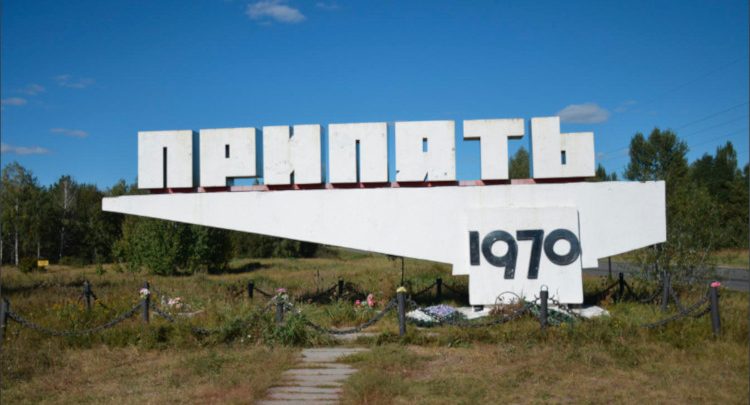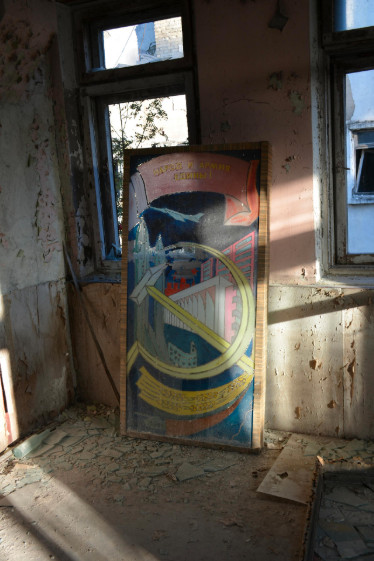Photos From Chernobyl

(guest post by Amanda DeGroof)
I was recently asked what my ultimate bucket list trip would be. Perhaps a sunny beach, or a romantic spot in Europe? No, my answer was “Fukushima”. And prior to last year, it would have been “Chernobyl”.
I’ve long been obsessed with abandoned places; the more eerie the history, the better. I’ve been to abandoned mental asylums, disused underground tunnels, and the town of Centralia, just to name a few. And when you combine this with another passion of mine, nuclear energy and, more specifically, the events when it goes astray, you can see why I chose the places I did.
There is a website I’ve been reading for many years called Atlas Obscura. They map and give history and details of unusual places around the world. And they also conduct interesting tours, which are strictly limited to under a dozen brave souls who want to explore the Arctic by boat or examine the medieval villages of Romania. I received an email from them in early 2018 touting their September tour promising hidden gems of Kyiv, and more importantly, two days touring Chernobyl and the abandoned nuclear town of Pripyat.

When I excitedly related the details of the trip to my husband, he made it clear that this was not his kind of tour. He’s definitely more of a resort at the beach sort, rather than the adventure travel that I enjoy. Not to say I’ll pass up a week in Playa del Carmen, but I also love snorkeling in the cenotes and ziplining in the forests of Mexico.
Not dissuaded, I put down a substantial deposit to hold my space on the Ukraine tour. Having spent the past almost 30 years of my life reading about and perusing photos of the 1986 disaster, I wasn’t going to miss the opportunity to see it for myself.
In September, I carefully packed the recommended raincoat, sunscreen, and other necessities. I had searched online, and the average temperature in Kyiv in early September is usually in the low 60s Fahrenheit, so I brought long-sleeved shirts and jeans, along with a few jackets and sweaters. Then I headed out on my direct flight to London, and from there, another five-hour flight to Kyiv.

Upon reaching the Boryspil airport, I discovered that the climate had decided not to be average this year – the temps were in the mid-to-upper 70s with lots of sun. So while my wardrobe was not ideal for the warm weather, I would have plenty of long sleeves and long pants required for entry to the Exclusion Zone.
After spending several exhausting, non-stop days touring various parts of Kyiv, we got on a small tour van for our trip to Chernobyl. During the two-hour ride, we watched a fascinating documentary about the hours leading up to the disaster, and the major players in the event. Much of it I had read before, but there were some details I hadn’t heard before.
As we drove closer, we hit various government checkpoints. These involved large gated barriers, and lots of men with guns and obvious military training. They don’t mess around with entry into the Zone. At each one, we had to show our passports, then get out of the van and let the guards verify that there was one person who matched each passport. There is a closely kept list of those permitted to enter the Zone on any given day, and they needed to check that everyone was on that list as well. At one stop, we signed a long document that was part waiver and part a listing of the many, many rules for what is not allowed inside the Zone: don’t touch anything, don’t go inside the buildings, don’t take anything with you, don’t feed the stray dogs, and more. We all had to sign this document in order to be allowed to enter.


Finally, we arrived at our destination. We started off at the power plant itself, going to the usual touristy spots – the monuments and memorials in the small, bricked-in square outside of the plant buildings themselves, the Monument to Those Who Saved the World, and the small international monument that stands just outside the fenced area that houses the former Reactor Four, which was covered by the Sarcophagus shortly after the incident, and more recently by the New Safe Confinement structure. Our tour guide brought out the dosimeter and made a big deal over checking the radiation levels here – they were fairly low, similar to what you would get as background radiation in any large city.

Then, things started to get more interesting. We entered the incomplete cooling tower for the never-finished Reactor Five. Although we certainly weren’t the first to enter, as evidenced by the substantial amount of graffiti and debris scattered about, it was eerily quiet and empty. There was a beautiful — painting? graffiti? — of a man with a mask tied across his face. It was absolutely haunting.
Our tour group then proceeded into the Chernobyl workers’ canteen for lunch. When you enter the building, you are greeted by a row of large, metal contraptions with red and green lights on them. These are the radiation detectors, and we became very familiar with them during our time in Chernobyl. Essentially, you step up onto a small platform inside the machine, brace your feet where the foot outlines are, then place your hands on pads on either side of the machine. It scans you to ensure that no radioactive particles are brought inside the canteen.
Since none of us spoke Ukranian or Russian, our guide helped us to get food at the canteen. I, having celiac, discovered that there wasn’t much to offer a visitor who couldn’t eat wheat – the meat was coated in an outer breaded shell, even the vegetables had grain in them – and when the guide explained that I was gluten-free, the woman behind the counter opened a mini-fridge and, oddly, handed me a plate with two pieces of watermelon on it. This was to be my gluten-free lunch.
After lunch, we headed to Pripyat, the nuclear town established for the workers at Chernobyl and their families. One thing that immediately stood out – the Exclusion Zone is enormous. Pripyat is a large city and spans many kilometers of land. While some of the roads have been (somewhat) maintained for tourism’s sake, the others are either overgrown with trees, bushes, and other foliage growing up through the street, or have been rendered useless due to toppled trees and other debris.

Despite the papers signed at the checkpoints, we went in many of the buildings. They were full of broken glass, fallen ceiling tiles, and the like, and as there was no electricity it was often dark inside. We had to be very careful where we stepped, and be extremely quiet while we went through the buildings, as it was illegal to be inside them, and the police regularly patrol the area. Getting caught means being thrown out of the Exclusion Zone and the tour guide either getting a fine or a ban from entering.
After a while, you begin to notice the quiet. While our tour group was slightly noisy, talking and crunching over debris as we toured the buildings, the usual sounds that we take for granted were eerily absent: traffic, trains, electrical machinery, ventilation… They were all non-existent. The quiet was all-consuming. We rarely even heard bird calls.
Getting into some of the buildings involved some serious leg work. We often had to go through very overgrown areas, with weeds and other underbrush sometimes going up past my chest. The zone requires that you wear long pants and long sleeves, and as we explored I was glad I’d obeyed that part of the rules – it helped to keep the ticks at bay.


At one point, we entered one of the 15 former primary schools in Pripyat. It was a mess, with the floor completely covered in pieces and pages of old books. It hurt to be stepping on former educational reading material, now so much debris and trash in this empty place. Everywhere we went, there were murals, pictures, and propaganda praising communism and Lenin. The hammer and sickle were ubiquitous inside the buildings, as well as on monuments throughout the city.
There was a large factory, which appeared to have made some sort of electronics in its working life. There were bits of circuit boards and other machinery strewn throughout the building and the grounds. I was shocked at how many of the other people on the tour didn’t hesitate to pick things up and examine them. Since there was no running water anywhere on property to wash our hands, I was careful never to touch anything at all.

On day two of the tour, we stopped in the hospital where the firefighters were taken after trying to extinguish the “roof fire” at Reactor Four. The firefighters’ gear remains in the basement of the hospital, too radioactive to get near or be disposed of. We walked partway into the basement stairs with the dosimeter, and it pegged the needle at the top and screamed the danger to us. The guide turned it off.
There were so many buildings, and so much I wanted to see, but we only had a day and a half of tour time. After the second day, I was exhausted, dirty, dehydrated, and ready to board the van again and return to Kyiv. On the way out, we had to stop at two more checkpoints to step into the radiation scanners again. One of the guides’ shoes set off the alarm, and he had to get them swabbed off by the guards. Then we were cleared to go.

The whole trip was incredible. I saw so many things that I had wanted to experience for so long, and to have gotten the chance to go there, was just overwhelming. Would I go back? No, probably not – I’ve seen most of what I came to see, and there are many other places and experiences that are still on my bucket list. If you are interested in getting more information about Chernobyl and the disaster that happened there, I highly recommend the books “Chernobyl 01:23:40: The Incredible True Story of the World’s Worst Nuclear Disaster” by Andrew Leatherbarrow (free with KIndle Unlimited) and “Voices from Chernobyl” by Svetlana Alexievitch. And of course, the incredible HBO miniseries “Chernobyl”.
More pictures are available at Photos From Chernobyl.
